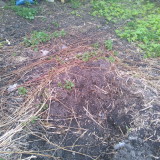In a small village Dolní Chobolice in Norhern Bohemia a torso of a small calvary is situated at the corner of old stone hause.
Nothing extraordinary – there are thousands of such calvaries disseminated in Czech lands, mostly near crossroads, roads and memorial places.
My neighbour Pavel has been making some earthworks (cleaning the road ditch) 30 metres aside the cavalry and has found a rectangular shaped stone sunken in a mud. After a while (and some cleaning from clay and debris) it became clear that a missing part of cavalry was found. The stone fits on the top of cavalry torso perfectly and only its color indicates the stone was left a few years in the soil and rubbish (it is sandstone and even after proper cleaning this piece remains of “muddy” grayish undertone; Fig. 01 – 02).
- The calvary – front view. Remark the color difference.
- The calvary – side view. Remark the color difference.
We spent a few hours of sniffing for information next week. Eventualy the puzzle was successfuly finished:
Sometimes in fifties (a few years after the Communist coup d’état in 1948) there was brutal general movement against Catholic Church in compliance with perverted Marx’s “religion is the opium of the people” statement. Besides the monasteries closure and churches desacralisation the country monuments were physicaly destroyed as well.
“Our” calvary was destroyed by railway employees who fulfilled their duty with little care and threw the calvary upper part in nearest ditch. This part came to the light after 60 years of lying in the mud (Fig. 03 – 05).
- The calvary upper part was desttroyer and thrown into road ditch right apart.
- Cleaning the ditch brings the calvary fragment to light.
- A hole in the soil where the upper part was found.
I did a small 3D modeling of an object still waiting for a complete reconstruction.
And why is this post in thinking stratigraphy category? It is very sparse to find the whole way of a standing structure part from its original location to archaeological deposition and vice-versa.





